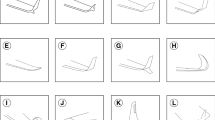Abstract
To aim at design requirements of high lift-to-drag ratio as well as high volumetric efficiency of next generation hypersonic airplanes, a body-wing-blending configuration with double flanking air inlets layout is presented. Moreover, a novel forebody design methodology which by rotating and assembling two waverider-based surfaces is firstly introduced in this paper. Some typical configurations are designed and their aerodynamic performances are evaluated by computational fluid dynamics. The results for forebodies analysis show that large volumetric efficiency, high lift-to-drag ratio, and uniformly distributed flowfield at the inlet cross section can be assured simultaneously. Furthermore, results of numerical simulation of four integrated configurations with various leading edge shapes, including three power-law curves and a cosine curve clearly show the advantage of high lift-to-drag ratio. Besides, the high pressure generated by the side wall of the airframe can be partly captured by the reasonably designed wings in the condition of small flight attack angle. Then the order of lift-to-drag ratio of four configurations at 0 degree flight attack angle is completely different from the condition of 4-degree flight attack angle. This result demonstrates that the curve shape of the leading edge is very important for the lift-to-drag ratio of the aircraft, and it should be further optimized under the cruising attack angle in future work.
Similar content being viewed by others
References
Cui E J. Research statutes, development trends and key technical problems of near space flying vehicles (in Chinese). Adv Mech, 2009, (6): 658–673
Le J L. Progress in air-breathing hypersonic technology (in Chinese). J Southwest Univ Sci Technol, 2011, 26(4): 1–9
Ye Y D. Study on aerodynamic characteristic and design of optimization for high speed near space vehicles (in Chinese). Adv Mech, 2009, (6): 683–694
Bertin J J, Cummings R M. Fifty years of hypersonics: where we’ve been, where we’re going. Prog Aerosp Sci, 2003, 39(6): 511–536
Bakos R. Current hypersonic research in the USA. Adv Propul Technol High-Speed Aircr, 2008, 10: 1–26.
Huang W, Li S B, Liu J, et al. Investigation on high angle of attack characteristics of hypersonic space vehicle. Sci China Tech Sci, 2012, 55(5): 1437–1442
You Y C, Liang D W. Design concept of three-dimensional section controllable internal waverider hypersonic inlet. Sci China Tech Sci, 2009, 52(7): 2017–2028
Lewis M J. A hypersonic propulsion airframe integration overview. AIAA-2003-4405, 2003
Zhang M Z, Zou Y. Development of American typical hypersonic flight vehicles and its enlightenment (in Chinese). J Rock Propul, 2012, 38(2): 1–8
Mölder S. Internal, axisymmetric, conical flow. AIAA J, 1967, 7(5): 1252–1255
Billig F S, Baurle R A, Tam C J. Design and analysis of streamline traced hypersonic inlets. AIAA-1999-4974, 1999
Sun B, Zhang K Y. Experimental investigation and numerical simulation of hypersonic Busemann inlet (in Chinese). J Propul Technol, 2006, 27(1): 58–61
Kothari A P, Tarpley C, McLaughlin T. Hypersonic vehicle design using inward turning flowfields. 32nd AIAA/SAE/ASME/ASEE Joint Propulsion Conference, AIAA, 1996
Kothari A P. Designs of and methodology for inward or outward, and partially inward or outward turning flow hypersonic air-breathing and rocket-based-combined-cycle vehicles. Patent Application Publication, US 6164596 A, USA, 2000
Tan H J, Chen Z, Li G S. A new concept and preliminary study of variable hypersonic inlet with fixed geometry based on shockwave control. Sci China Tech Sci, 2007, 50(5): 644–657
Huang W, Li S B, Liu J, et al. Effect of cavity flame holder configuration on combustion flow field performance of integrated hypersonic vehicle. Sci China Tech Sci, 2010, 53(10): 2725–2733
Takashima N, Lewis M J. Engine-airframe integration on osculating cone waverider-based vehicle designs. AIAA-1995-2551, 1995
O’Neill M K L, Lewis M J. Optimized scramjet integration on a wave-rider. J Aircr, 1992, 29(6): 1114–1121
Cui K, Zhao D X, Yang G W. Waverider configurations derived from general conical flowfields. Acta Mech Sin, 2007, 23(3): 247–255
Cui K, Yang G W. The effect of conical flowfields on the performance of waveriders at Mach 6. Chin Sci Bull, 2007, 52(1): 57–64
Che J, Tang S, Bingnan K. Airframe/scramjet integrated design of hypersonic cruise vehicle. AIAA-2007-642, 2007
Townend L H. On hypersonic cruising aircraft which can have all leading edges swept. Part I, Design of air intakes. RAE Report TR 67046, 1967
Zhu Y, Li T. Overview of caret inlet researches (in Chinese). Aircr Design, 2003, (1): 1–6
Yang Y K. The research of bump inlet design and test (in Chinese). Acta Aerodyn Sin, 2007, 25(3): 336–338
Zhu Y, Li T. The study of BUMP intake design (in Chinese). Proceedings of the First National Symposium of Mechanics Problems in the Aerospace Field (Part 1), Chengdu, Sichuan, 2004
Elvin J D. Integrated inward turning inlets and nozzles for hypersonic air vehicles. European Patent Application EP 1818257, 2007
Walker S H, Sherk J, Shell D. The DARPA/AF falcon program: the hypersonic technology vehicle# 2(HTV-2) flight demonstration phase. AIAA-2008-2539, 2008
Tu G H, Deng X G, Mao M L. Validation of a RANS transition model using a high-order weighted compact nonlinear scheme. Sci China Phys Mech Astron, 2013, 56(4): 805–811
Fan M, Cao W, Fang X J. Prediction of hypersonic boundary layer transition with variable specific heat on plane flow. Sci China Phys Mech Astron, 2011, 54(11): 2064–2070
Dong M, Zhou H. The effect of high temperature induced variation of specific heat on the hypersonic turbulent boundary layer and its computation. Sci China Phys Mech Astron, 2010, 53(11): 2103–2112
Wang L, Fu S. Modeling flow transition in a hypersonic boundary layer with Reynolds-averaged Navier-Stokes approach. Sci China Ser G-Phys Mech Astron, 2009, 52(5): 768–774
Author information
Authors and Affiliations
Corresponding author
Rights and permissions
About this article
Cite this article
Cui, K., Hu, S., Li, G. et al. Conceptual design and aerodynamic evaluation of hypersonic airplane with double flanking air inlets. Sci. China Technol. Sci. 56, 1980–1988 (2013). https://doi.org/10.1007/s11431-013-5288-0
Received:
Accepted:
Published:
Issue Date:
DOI: https://doi.org/10.1007/s11431-013-5288-0




